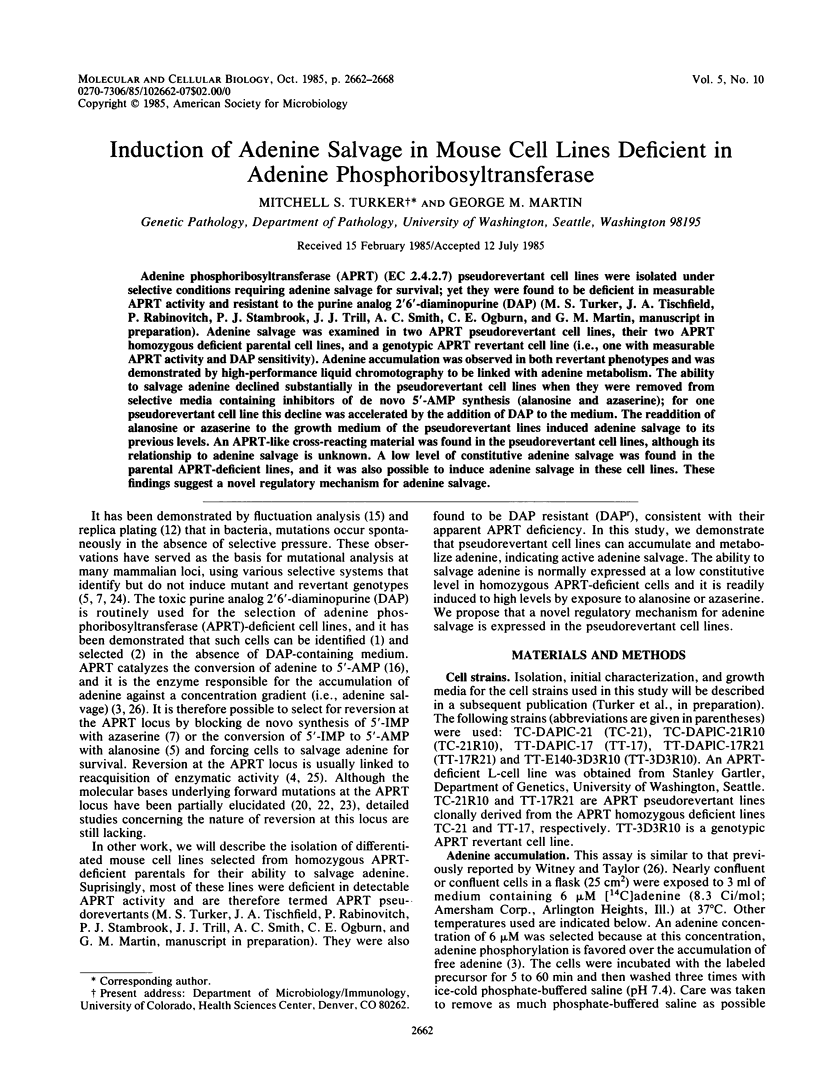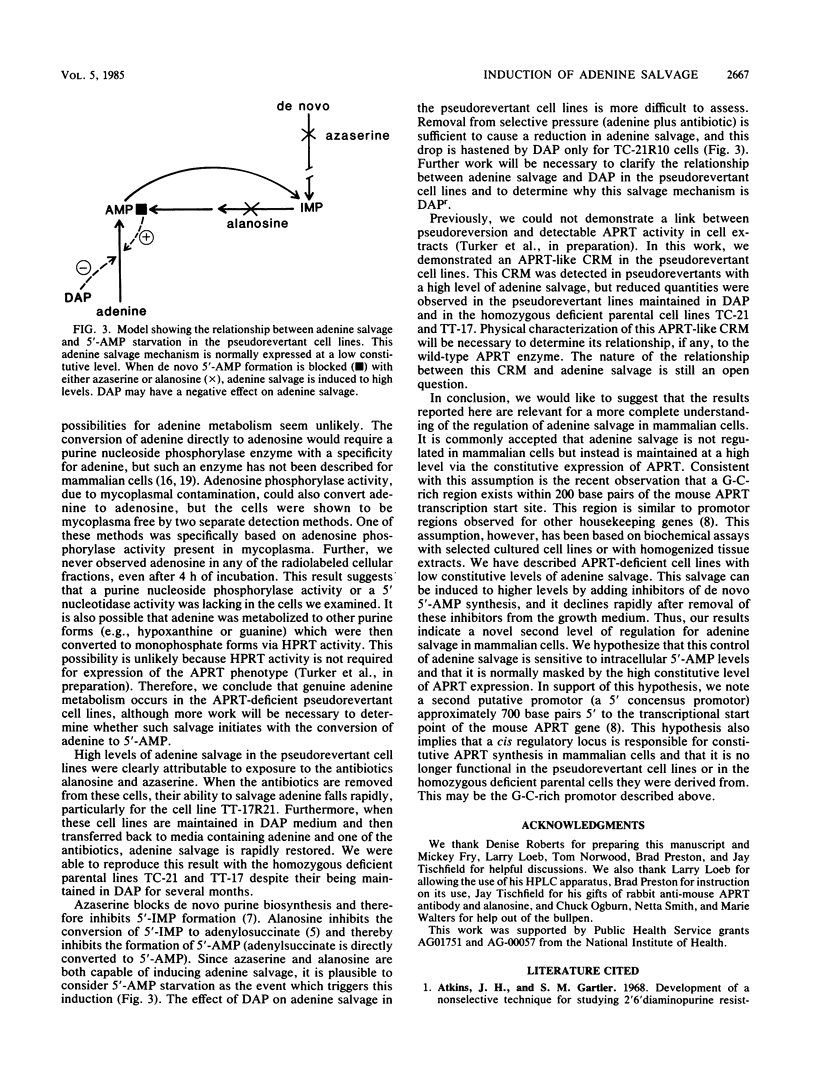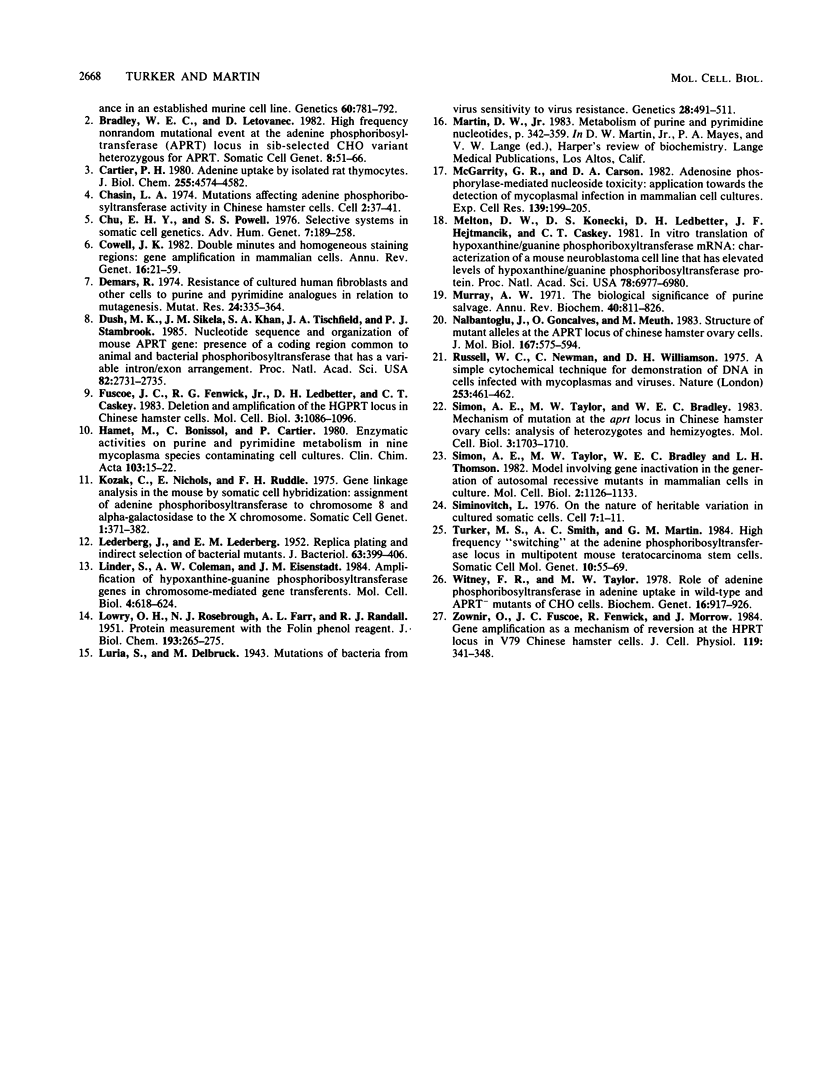Abstract
Adenine phosphoribosyltransferase (APRT) (EC 2.4.2.7) pseudorevertant cell lines were isolated under selective conditions requiring adenine salvage for survival; yet they were found to be deficient in measurable APRT activity and resistant to the purine analog 2'6'-diaminopurine (DAP) (M.S. Turker, J. A. Tischfield, P. Rabinovitch, P.J. Stambrook, J.J. Trill, A.C. Smith, C.E. Ogburn, and G.M. Martin, manuscript in preparation). Adenine salvage was examined in two APRT pseudorevertant cell lines, their two APRT homozygous deficient parental cell lines, and a genotypic APRT revertant cell line (i.e., one with measurable APRT activity and DAP sensitivity). Adenine accumulation was observed in both revertant phenotypes and was demonstrated by high-performance liquid chromatography to be linked with adenine metabolism. The ability to salvage adenine declined substantially in the pseudorevertant cell lines when they were removed from selective media containing inhibitors of de novo 5'-AMP synthesis (alanosine and azaserine); for one pseudorevertant cell line this decline was accelerated by the addition of DAP to the medium. The readdition of alanosine or azaserine to the growth medium of the pseudorevertant lines induced adenine salvage to its previous levels. An APRT-like cross-reacting material was found in the pseudorevertant cell lines, although its relationship to adenine salvage is unknown. A low level of constitutive adenine salvage was found in the parental APRT-deficient lines, and it was also possible to induce adenine salvage in these cell lines. These findings suggest a novel regulatory mechanism for adenine salvage.
Full text
PDF






Selected References
These references are in PubMed. This may not be the complete list of references from this article.
- Atkins J. H., Gartler S. M. Development of a nonselective technique for studying 2, 6, diaminopurine resistance in an established murine cell line. Genetics. 1968 Dec;60(4):781–792. doi: 10.1093/genetics/60.4.781. [DOI] [PMC free article] [PubMed] [Google Scholar]
- Bradley W. E., Letovanec D. High-frequency nonrandom mutational event at the adenine phosphoribosyltransferase (aprt) locus of sib-selected CHO variants heterozygous for aprt. Somatic Cell Genet. 1982 Jan;8(1):51–66. doi: 10.1007/BF01538650. [DOI] [PubMed] [Google Scholar]
- Cartier P. H. Adenine uptake by isolated rat thymocytes. J Biol Chem. 1980 May 25;255(10):4574–4582. [PubMed] [Google Scholar]
- Chasin L. A. Mutations affecting adenine phosphoribosyl transferase activity in Chinese hamster cells. Cell. 1974 May;2(1):37–41. doi: 10.1016/0092-8674(74)90006-3. [DOI] [PubMed] [Google Scholar]
- Chu E. H., Powell S. S. Selective systems in somatic cell genetics. Adv Hum Genet. 1976;7:189–258. doi: 10.1007/978-1-4757-0659-8_5. [DOI] [PubMed] [Google Scholar]
- Cowell J. K. Double minutes and homogeneously staining regions: gene amplification in mammalian cells. Annu Rev Genet. 1982;16:21–59. doi: 10.1146/annurev.ge.16.120182.000321. [DOI] [PubMed] [Google Scholar]
- DeMars R. Resistance of cultured human fibroblasts and other cells to purine and pyrimidine analogues in relation to mutagenesis detection. Mutat Res. 1974 Sep;24(3):335–364. doi: 10.1016/0027-5107(74)90180-8. [DOI] [PubMed] [Google Scholar]
- Dush M. K., Sikela J. M., Khan S. A., Tischfield J. A., Stambrook P. J. Nucleotide sequence and organization of the mouse adenine phosphoribosyltransferase gene: presence of a coding region common to animal and bacterial phosphoribosyltransferases that has a variable intron/exon arrangement. Proc Natl Acad Sci U S A. 1985 May;82(9):2731–2735. doi: 10.1073/pnas.82.9.2731. [DOI] [PMC free article] [PubMed] [Google Scholar]
- Fuscoe J. C., Fenwick R. G., Jr, Ledbetter D. H., Caskey C. T. Deletion and amplification of the HGPRT locus in Chinese hamster cells. Mol Cell Biol. 1983 Jun;3(6):1086–1096. doi: 10.1128/mcb.3.6.1086. [DOI] [PMC free article] [PubMed] [Google Scholar]
- Hamet M., Bonissol C., Cartier P. Enzymatic activities on purine pyrimidine metabolism in nine mycoplasma species contaminating cell cultures. Clin Chim Acta. 1980 Apr 11;103(1):15–22. doi: 10.1016/0009-8981(80)90225-9. [DOI] [PubMed] [Google Scholar]
- Kozak C., Nichols E., Ruddle F. H. Gene linkage analysis in the mouse by somatic cell hybridization: assignment of adenine phosphoribosyltransferase to chromosome 8 and alpha-galactosidase to the X chromosome. Somatic Cell Genet. 1975 Oct;1(4):371–382. doi: 10.1007/BF01538668. [DOI] [PubMed] [Google Scholar]
- LEDERBERG J., LEDERBERG E. M. Replica plating and indirect selection of bacterial mutants. J Bacteriol. 1952 Mar;63(3):399–406. doi: 10.1128/jb.63.3.399-406.1952. [DOI] [PMC free article] [PubMed] [Google Scholar]
- LOWRY O. H., ROSEBROUGH N. J., FARR A. L., RANDALL R. J. Protein measurement with the Folin phenol reagent. J Biol Chem. 1951 Nov;193(1):265–275. [PubMed] [Google Scholar]
- Linder S., Coleman A. W., Eisenstadt J. M. Amplification of hypoxanthine-guanine phosphoribosyltransferase genes in chromosome-mediated gene transferents. Mol Cell Biol. 1984 Apr;4(4):618–624. doi: 10.1128/mcb.4.4.618. [DOI] [PMC free article] [PubMed] [Google Scholar]
- Luria S. E., Delbrück M. Mutations of Bacteria from Virus Sensitivity to Virus Resistance. Genetics. 1943 Nov;28(6):491–511. doi: 10.1093/genetics/28.6.491. [DOI] [PMC free article] [PubMed] [Google Scholar]
- McGarrity G. J., Carson D. A. Adenosine phosphorylase-mediated nucleoside toxicity. Application towards the detection of mycoplasmal infection in mammalian cell cultures. Exp Cell Res. 1982 May;139(1):199–205. doi: 10.1016/0014-4827(82)90333-0. [DOI] [PubMed] [Google Scholar]
- Melton D. W., Konecki D. S., Ledbetter D. H., Hejtmancik J. F., Caskey C. T. In vitro translation of hypoxanthine/guanine phosphoribosyltransferase mRNA: characterization of a mouse neuroblastoma cell line that has elevated levels of hypoxanthine/guanine phosphoribosyltransferase protein. Proc Natl Acad Sci U S A. 1981 Nov;78(11):6977–6980. doi: 10.1073/pnas.78.11.6977. [DOI] [PMC free article] [PubMed] [Google Scholar]
- Murray A. W. The biological significance of purine salvage. Annu Rev Biochem. 1971;40:811–826. doi: 10.1146/annurev.bi.40.070171.004115. [DOI] [PubMed] [Google Scholar]
- Nalbantoglu J., Goncalves O., Meuth M. Structure of mutant alleles at the aprt locus of Chinese hamster ovary cells. J Mol Biol. 1983 Jul 5;167(3):575–594. doi: 10.1016/s0022-2836(83)80099-0. [DOI] [PubMed] [Google Scholar]
- Russell W. C., Newman C., Williamson D. H. A simple cytochemical technique for demonstration of DNA in cells infected with mycoplasmas and viruses. Nature. 1975 Feb 6;253(5491):461–462. doi: 10.1038/253461a0. [DOI] [PubMed] [Google Scholar]
- Siminovitch L. On the nature of hereditable variation in cultured somatic cells. Cell. 1976 Jan;7(1):1–11. doi: 10.1016/0092-8674(76)90249-x. [DOI] [PubMed] [Google Scholar]
- Simon A. E., Taylor M. W., Bradley W. E. Mechanism of mutation at the aprt locus in Chinese hamster ovary cells: analysis of heterozygotes and hemizygotes. Mol Cell Biol. 1983 Oct;3(10):1703–1710. doi: 10.1128/mcb.3.10.1703. [DOI] [PMC free article] [PubMed] [Google Scholar]
- Simon A. E., Taylor M. W., Bradley W. E., Thompson L. H. Model involving gene inactivation in the generation of autosomal recessive mutants in mammalian cells in culture. Mol Cell Biol. 1982 Sep;2(9):1126–1133. doi: 10.1128/mcb.2.9.1126. [DOI] [PMC free article] [PubMed] [Google Scholar]
- Turker M. S., Smith A. C., Martin G. M. High frequency "switching" at the adenine phosphoribosyltransferase locus in multipotent mouse teratocarcinoma stem cells. Somat Cell Mol Genet. 1984 Jan;10(1):55–69. doi: 10.1007/BF01534473. [DOI] [PubMed] [Google Scholar]
- Witney F. R., Taylor M. W. Role of adenine phosphoribosyltransferase in adenine uptake in wild-type and APRT- mutants of CHO. Biochem Genet. 1978 Oct;16(9-10):917–926. doi: 10.1007/BF00483743. [DOI] [PubMed] [Google Scholar]
- Zownir O., Fuscoe J. C., Fenwick R., Morrow J. Gene amplification as a mechanism of reversion at the HPRT locus in V79 Chinese hamster cells. J Cell Physiol. 1984 Jun;119(3):341–348. doi: 10.1002/jcp.1041190313. [DOI] [PubMed] [Google Scholar]


